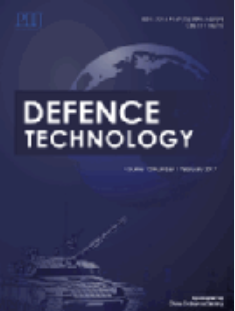低温处理对 AA5754 合金搅拌摩擦焊接接头机械性能和弹道性能的影响
IF 5.9
Q1 ENGINEERING, MULTIDISCIPLINARY
引用次数: 0
摘要
在本研究中,研究了搅拌摩擦焊接(FSW)铝合金(AA5754)试样在未处理和低温处理的情况下,在7.62 mm穿甲弹(AP)以682±20 m/s的冲击速度撞击下的力学性能和弹道性能。采用FSW技术制备AA5754焊接试样,轴向力为7 kN,进给速度为20 mm/min,转速为1200 rpm。焊接后进行低温处理,包括- 196°C的深低温处理(DCT)和- 80°C的浅低温处理(SCT),分别持续6和72小时。研究了低温处理和未低温处理的接头组织和力学特性。低温处理使晶粒细化(1.05 μm),显微硬度提高(93 Hv)。此外,与未经处理的FSW样品相比,DCT-FSW显著提高了拉伸强度(13.93%)和冲击强度(8.45%)。此外,在未经处理的FSW样品中,断裂行为有所不同:冲击断裂模式主要表现为韧性断裂,而拉伸断裂表现为混合断裂模式。相反,DCT-FSW的拉伸和冲击断裂模式以延性破坏模式为主。与SCT-FSW和未处理的FSW靶相比,DCT-FSW靶的穿透深度(DOP)较低,为31 mm。在所有三个区域的弹坑区域的弹道后SEM分析显示,形成了摩擦沟槽,小裂纹和绝热剪切带(asb)。本文章由计算机程序翻译,如有差异,请以英文原文为准。
Influence of cryogenic treatment on mechanical and ballistic properties of AA5754 alloy friction stir welded joints
In the present study, the mechanical and ballistic properties of friction stir welded (FSW) aluminum alloy (AA5754) samples were investigated, both untreated and cryogenically treated, when impacted by a 7.62 mm armour-piercing (AP) bullet at an impact velocity of 682±20 m/s. The FSW technique was used to prepare the welded samples for AA5754, with an axial force of 7 kN, a feed rate of 20 mm/min, and a speed of 1200 rpm. The cryogenic treatments performed after welding, including deep cryogenic treatment (DCT) at −196 °C and shallow cryogenic treatment (SCT) at −80 °C, for 6 and 72 h, respectively. The microstructure and mechanical characteristics of cryogenically treated and untreated joints were examined. The cryogenic treatment refined the grain size (1.05 μm) and enhanced the microhardness (93 Hv). Moreover, DCT-FSW significantly improved the tensile strength (13.93%) and impact strength (8.45%) compared to untreated FSW sample. Additionally, in untreated FSW samples, the fracture behaviour varied: the impact fracture mode primarily exhibited ductile failure, while the tensile fracture exhibited a mixed fracture mode. In contrast, the tensile and impact fracture modes of the DCT-FSW were dominated by a ductile failure mode. The DCT-FSW target demonstrated a lower depth of penetration (DOP) of 31 mm compared to the SCT-FSW and untreated FSW targets. Post-ballistic SEM analysis in the crater region of all three zones revealed the formation of frictional grooves, small cracks, and adiabatic shear bands (ASBs).
求助全文
通过发布文献求助,成功后即可免费获取论文全文。
去求助
来源期刊

Defence Technology(防务技术)
Mechanical Engineering, Control and Systems Engineering, Industrial and Manufacturing Engineering
CiteScore
8.70
自引率
0.00%
发文量
728
审稿时长
25 days
期刊介绍:
Defence Technology, a peer reviewed journal, is published monthly and aims to become the best international academic exchange platform for the research related to defence technology. It publishes original research papers having direct bearing on defence, with a balanced coverage on analytical, experimental, numerical simulation and applied investigations. It covers various disciplines of science, technology and engineering.
 求助内容:
求助内容: 应助结果提醒方式:
应助结果提醒方式:


